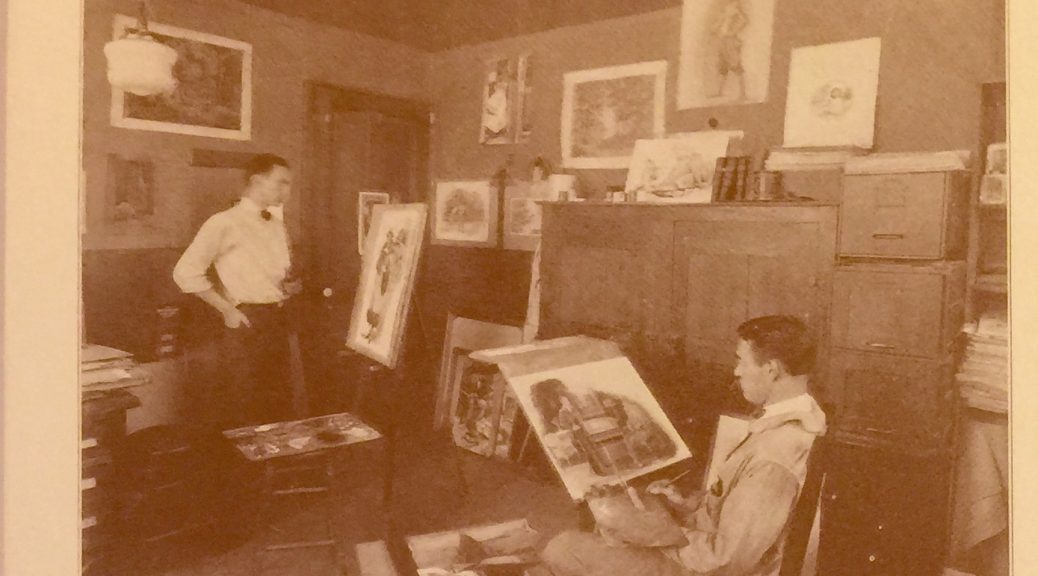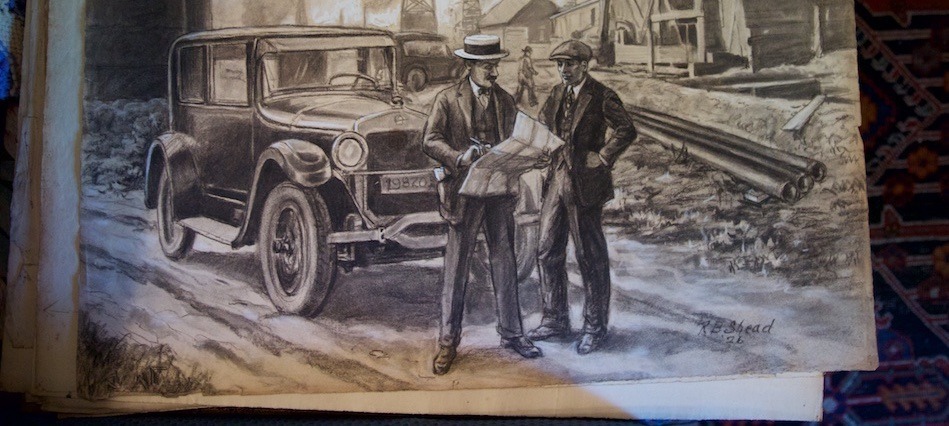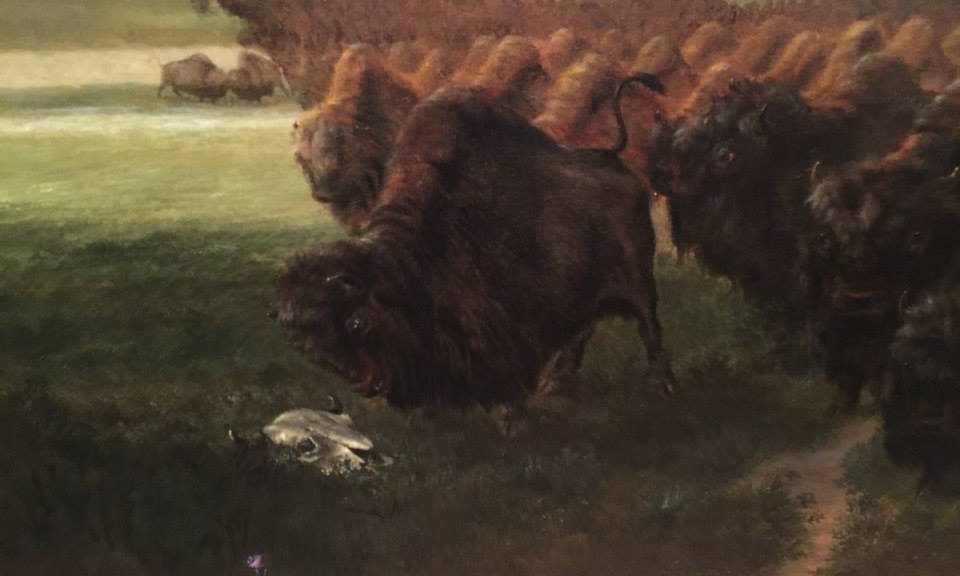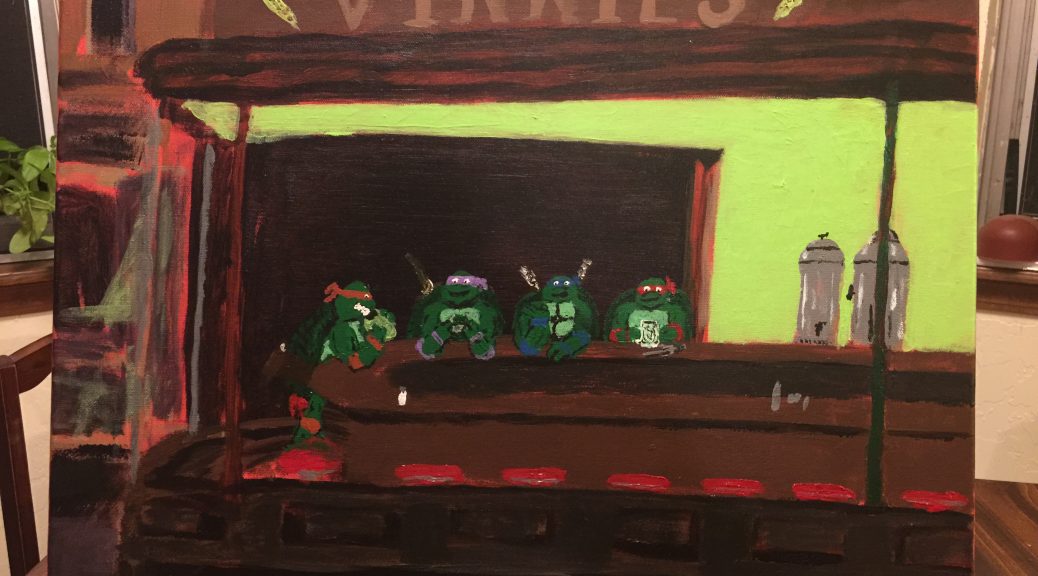If you have been following along, you will recognize the crescendo of this Shead story has taken over my posts and summer research. It is hard to think of anything else I could add to what I’ve discovered so far save just adding to his already herculean numbers of completed pieces of art. Following the magazine covers that were part of his enormous portfolio and utilizing the interlibrary loan services at my library I secured a few copies of the Specialty Salesman Magazine.
Tag Archives: art
R.B. Shead: Pre-Museum Years
Several days after visiting with Ralph’s great nephew, Bill, he called me to say he had found a small watercolor study for one of the old museum dioramas and a few charcoal studies that Ralph had done as a student and others that were originals submitted as accompanying illustrations for short stories.
I was finally able to go back with my camera and take better photos of the paintings as well as look at these new finds. Those “few” sketched turned out to be an enormous century-old portfolio filled with over 100 pieces of art that Ralph had done either for story illustrations, studies, or magazine cover layouts. I was in awe.
The Road to Comps part 16: Art and the American West in the 19th Century: Studies of Individual Artists
This will be one of the shortest posts made on this travelogue through everything in print (Every time I start this way I drone on for over 1000 words). This is not due to the end of the semester doldrums (I’ve been on 12 -month work contracts since moving up here) or the holidays (I’d rather not do them), but because the bulk of what I have read is review of review of things that I have already written about at great length. In fact, it was precisely such foci that started my posting in earnest as I collected and transcribed my notes for class. In addition to typing up the notes I was able to track down most of the images that we used in class and included them in with their appropriate author. There is no need to re-invent the wheel at this point, so I will link to them throughout the post. This is an excellent time to realize that my previous work is now back paying dividends.
Before moving on to the two main points I want to make in this post, I wish to take a moment to remark on the shifts of formulas in the books read about individual artists. I have moved on from the rubrics of “academic” writing and fallen into the interesting (and more visually appealing) gallery books that accompanied exhibits across the United States (and sometimes farther). These collections of essays group around the artists whose work is on display and offers just enough insight to be interesting but not so much as to be overly useful for comprehensive exams preparation. I have enjoyed them though.
Early in my foray into the Art History department I made a remark about there being so few artist biographies. One of the other students (now a director at a museum in New Mexico) voiced disagreement, but offered no examples outside of these collected essays or a few pages of encyclopedia entries. I still stand by my complaint. I am not suggesting separating the artist from their work, but more bringing in as full a context as we can manage for the world their work was a part of.
What can be done is something along the lines of what Benita Eisler does for George Catlin in The Red Man’s Bones. I have read this book once before (and never got around to reviewing it which was what this whole stupid spelunk into blogging was supposed to be), but reading it a second time after reading about the culture of the growing United States, showmanship, art, and European tours, it is an even better example of taking someone who is currently existing “out of time” and putting them back into the structure that shaped there careers. For my take on Catlin see this old post.
Bierstadt and Bingham both have (excellent) posts of their own as well. I was actually able to visit the Bingham exhibit Navigating the West (which is the exhibit book that I just finished) and get a tour with the co-curator Nenette Luarca-Shoaf.
One of the best books in this section that isn’t currently being held for ransom by some other library patron (the Winslow Homer book will have to be edited back in this post or added to another one when it finally gets returned to the library) is Robert Taft’s Artists and Illustrators of the Old West 1850-1900. Each chapter is an excellent overview of an artist or a set of artists working in the same genre or region. Each one of these chapters could easily be made into a book. In fact, taking Taft as a starting point and Eisler as an end template I think one could make a lasting furrow into that lack of useful biography thing I mentioned earlier. The kicker with Taft’s work is that is was published in 1953. On a hunch I emailed one of my professors and asked if there were any updated versions or had anyone added to it. He replied there were some updated materials but no one has done it better than Taft. After finishing the book, I have to agree. It is one of those that has been added to the “purchase own copy” list that is an outgrowth of this project.

One of those included in Taft’s survey was William Jacob Hays. I bring this one up here because he might be lesser known than anyone mentioned here (or even in Taft’s book) but produced one of my favorite paintings that I have actually seen because it is at the Gilcrease Museum in Tulsa: Herd of Buffaloes on the Bed of the River Missouri. The sheer mass of the megafauna portrayed in the river bed give an idea of how many buffalo there were. I suppose thinking back to the environmental histories I have read here, it really is sort of the same thing as Burroughs’ poetry about nature and descriptions of the Passenger Pigeons. (this whole endeavor is turning into Dirk Gently’s Holistic detective agency).



Moving on from Taft and Buffalo I want to end with Alfred Jacob Miller and horses. Like the others I have reviewed Miller in previous posts but there are a few points to add here, less because they are new to the discussion and more because they are familiar to my life before the university: horses.
At the height of or equine days my family had 17 horses full under AQHA values, papers and all. Our number one stallion was born two weeks before I was and only recently died a year ago. Turns out he was 96 or 98% Foundation Quarter Horse which means that I could have completed all of my schooling and advanced degrees with the stud fees we never charged.
I tell that story to set up the one about Miller’s horses. When we first started looking at Miller’s paintings in class I recognized his horses all looked like Arabians which where the stock the Spanish brought back to the United States (I saw “back” because paleontologically speaking horses first evolved in the “new” world before invading the old and going extinct here). I never thought more about it until reading more about the complaints people have about Miller’s horses. They were too Arabian to be authentic wild ponies that the Indians were riding. This is the keystone in this whole putting the artist back into their context lamentation I keep tearing my sackcloth over. Miller may best be remembered for his commissions for the Scottish nobleman William Drummond Stewart.

Miller only ventured west for a few months of his life. His real mark of success (by that I mean living comfortably off his art) was back in Baltimore where he set up his studio in the center of the trade offices of the merchants, bankers, and lawyers. Just like real estate art patronage is all about location, location, location. These were the wellest-to-do of New England and were part of the growing trend in thoroughbred horse breeding and racing of which Arabians was choice starting stock. These were the people purchasing Miller’s work and commissioning his time. They expected to see Arabain horses, so that is what Miller gave them. Miller clearly had a feel for his genre, but he also had a handle on the desires of his audience. In addition to the real estate location, he also mastered another rule central to all forms of artistry–know your audience.
Just so they are most included, here is the link to my Karl Bodmer and Thomas Moran posts too. I will come back and add anything pertinent on Frederich Church or Winslow Homer if I find anything in this book:
The culmination of that course and all that blogging was a huge paper that was one of my favorites of writing since being at OU and, as it happens, may actually be a full third of my comprehensive exams: Artists on Expedition: Artifacts, Authenticity and Authority in Early 19th Century American Art of the American West.
The Road to Comps Part 7: Scenic Turnout 1
I have finally finished the first section of the comps list. This marks the end of the first “question” in theory if not practice. Most of my work crosses the subdivision created to make the list make more sense. Before I start to work on the rest (I am almost finished with the background section on the American Studies portion at the moment) I wanted to share some of the things I have learned about this type of work and how I manage to stay sane throughout the attempts to synthesize everything in print.
Scheduling. This seems obvious and impossible. It isn’t so much of “I must read 173 pages every 2 hours in order to finish this” as much as it is setting aside chunks of time to work on the sources, but also (and sometimes more importantly) having chunks of time where you don’t. Through the first few weeks I would use the weekends to catchup on things I missed and would marathon through 2 or 3 books each day on Saturday and Sunday. While this allowed me to get our regular blog posts and keep ahead of where I thought I should be it became a doldrum of monotony after two weeks. After I finished the first section I revamped the schedule and took another look at the list.
First thing I did was stop marathoning the weekends. I started to treat Saturday and Sunday like the rest of the days of the week (in relation to prepping for comps anyway). This means I get up at the same time but instead of going to work I take care of things around the house until the time I would be off anyway. Then I fix something to eat, watch my dinner episode of Teenage Mutant Ninja Turtles and set off to reading. This was less monotonous but wasn’t very different from the previous, and it wasn’t getting me any farther ahead on the readings.

I once was a boilermaker. I worked shutdowns in industrial maintenance. This means 7/12s (seven days a week, 12 hours each day) until the shutdown or turnaround was over. These typically lasted several weeks and then we would have time off until the next one. Turns out several weeks of the same thing is about all you can handle, especially when it is reading a normal size book a day (I saw “normal” to mean abound 350 pages which is about what I can digest in a day’s reading). So I took another look at the list and pulled out the calendar.
By putting a book on the calendar and doubling for some of these anthology pieces (and the Walt Whitman biography beast) and by getting up an hour earlier, I manage to free a full day on the weekend to do nothing related to comps. That probably isn’t entirely true as almost everything I end up doing finds its way into my work. But, hey, a day off! It also serves as a buffer in case something comes up that would interfere with our regularly schedule program. In the most recent case it was attending the opening of our Picturing Indian Territory exhibit at the art museum.

With the current schedule running, I am actually at the time of writing this, a day and book ahead, I will read the final book on my list a few days after Christmas. That is if I continue to treat the days of break as workdays. The days for blogging have been built in as well. This one was supposed to be tomorrow and the next a couple days later, but I think I can get two out this weekend (don’t look for that to become a common occurrence anytime soon).
What do I do on the days I am not reading? I spend it painting and pastelling random bits of pop culture from 80s cartoons. At least that is what the last one consisted of. It happened that the end of the first section and the second time I had a full day off hit together so I finished a prepared board and canvas in the morning and took a more ambitious project after lunch. In addition to arting it up, I have been utilizing my obsolete iPhone to try capture a time-lapse of the mess. Below are the time lapse creations of the fruits of a day off when I could have read at least two books:
The first was a prepared board for pastels for Egon talking to the King Troll from the episode Troll Bridge
As you can see the capturing system (and the art) is far from a professional affair. But I also had a small canvas for Orko, to celebrate the recent beginning of a 6 issue DC comics crossover of He-Man and the Thundercats.
The great thing about painting bits of cartoons from 30 years ago is they mainly use primary colors. This is extremely helpful for someone who is colorblind. In fact, since the pastels don’t have labels, I don’t do them unless my wife is here to double check skin tones or accessory colors. I suppose one day I will do something random as I see them or match them to what I see, but currently I would like them to be “right”
To that end, this one has been the most ambitious projects as far as size and content. I have done a couple ninja turtle acrylics before of Rocksteady and Bebop from the cartoons and then a panel from the new comics, but never have I situated them into actual art. It was actually a lot of fun, and I was surprised there there wasn’t a version of NightHawks with turtles somewhere on the internet. There isn’t one of the Ghostbusters (or the Real Ghostbusters) either so I might have to give that one a try some time.
This may seem like a waste of time, and I go back and forth on whether it is or not, but I do know that this small break in plowing through an enormous reading list has severed to make the workweek more tolerable. If you have made it this far and are wondering why you feel burned out over your work, you might try adjusting some things to give you a break. It doesn’t have to be painting, it could be bike riding, hiking, swimming, snow skiing, practicing the japanese noseflute, video games, something, anything, or even nothing. Comps (or generals) is one of those things that isn’t actually testing you for a “grade” in the sense that you have to remember a bunch of facts in an order in order to regurgitate them back for your professor. You are being “tested” in order to prove that you are suited and situated firmly enough into your discipline not to embarrass yourself in conversation with other people in your discipline. More than a few people will tell you that during preparations for comps “you will never know more about your field than you do now.” I know the sentiment and I am glad they share, but at the same time that isn’t really comforting to me.

The next scenic turnout may be art, or something else entirely. It might be a conglomeration of the things done on the days off between now and when I finish the next section, or something in the middle that think is more clever than it probably is.
Pipestone, Peeved Buffalo, and Painted Centaurs
Many pages have been written about George Catlin. The grand total falls somewhere close to an acre of paper timber (I completely made that up so don’t go putting it in your Catlin notes). That hyperbole is, in all actuality, probably a low estimate. Many more megabytes of data have been used on blogs and digital storage of some of his famous Indian paintings. If you ever get a chance you should look more in depth than here about his life, his showmanship, his critics, and his art. One day I hope to have a short post with some of his South America art too, but that is for a later time.
These are not a representative sample of his work, nor are they his best, or most reproduced. They are a few that we have seen in the course I am taking that have stood out to me for various reasons.
 |
| He Who Outjumps All |
 |
| The Little Spaniard |
 |
| Buffalo Bull Grazing |
Here Catlin has captured a Buffalo (yes I know it is Bison, there is a Far Side comic for you people) in a general state of agitation, and most definitely not grazing. At some point Catlin had wounded one in a hunt such that it could not charge or cause the artist harm and he circled it on horseback sketching the various moods. When the model grew tired, or held a pose longer than Catlin required he would throw something at him to agitate him more. He mentioned doing this with his hat. I am sure they later ate the buffalo that was killed as this was before the railroad sport and bio-warfare on the Indians dropped their numbers to critical extinction levels.
 |
| The Pipestone Quarry (don’t you love how someone can copyright an image that was painted almost two centuries ago?) |
I end this with a salute to those who study the smallest bits of the earth. Catlin was fortunate enough to see the quarries from whence the raw material for making the famous Indian pipes were created. The pipestone, alternately pipeclay is, for those keeping geological score, an argillite, that is a metamorphosed mudstone. Here Catlin has caught the scene at the mine, in a rough and almost martian landscape. The previous shards and layers split out around the quarry site with the hughe rock formations off to the right (note the tiny figure for scale, I think he is even pointing at it for you). These particular quarry was the first ever seen but white eyes and was in what is present day Minnesota. Other veins exist in Utah and a few other places, but this specific earthly concoction now bears the name Catlinite in the artist’s honor. Once again art and science come together reminding is why we have Colleges of Arts AND Sciences not Colleges of Arts OR Sciences.
Now go spend some time on Google Images looking at all of Catlin’s works.












